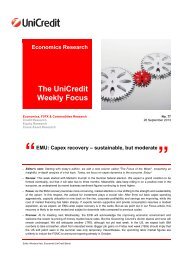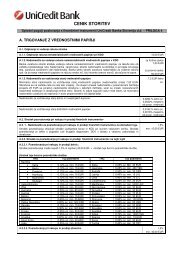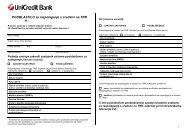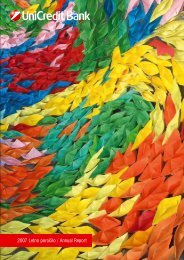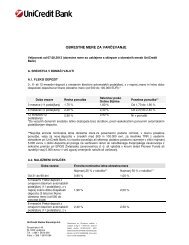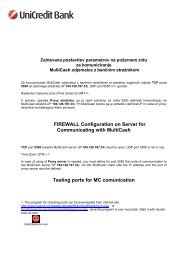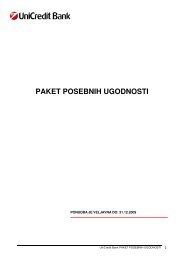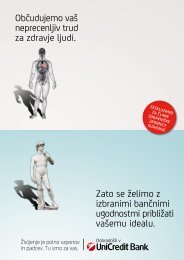Letno poroÄilo 2009.pdf - UniCredit Banka Slovenija dd
Letno poroÄilo 2009.pdf - UniCredit Banka Slovenija dd
Letno poroÄilo 2009.pdf - UniCredit Banka Slovenija dd
- No tags were found...
Create successful ePaper yourself
Turn your PDF publications into a flip-book with our unique Google optimized e-Paper software.
Financial StatementsSummary of Accounting Policiesexists, the Bank estimates the recoverable amount of the asset.An individual assessment of financial assets is used for all loans,apart from private customers, where a portfolio assessment of thequality of a financial asset is applied.(c) Held-to-maturity InvestmentsHeld-to-maturity investments are non-derivative financial assets withfixed or determinable payments and fixed maturities that the Bank hasthe positive intention and ability to hold to maturity.Held-to-maturity investments are measured at amortized cost.The Bank assesses at each reporting date whether there is anyindication that an asset may be impaired. If any such indicationexists, the Bank estimates the recoverable amount of the asset.(d) Available-for-sale Financial AssetsAvailable-for-sale financial assets are those non-derivative financialassets that are designated as available for sale or are not classifiedas loans and receivables, held-to-maturity investments or financialassets at fair value through profit or loss. This portfolio includes bothequity and debt securities.Subsequent to their initial recognition, available-for-sale financialassets are remeasured at their fair value. The Slovenian bond marketis characterized by rather low liquidity and low issue volumes.Consequently the market value as quoted on the stock exchangeregularly doesn’t reflect the fair value of a bond. In this the fair valueof the securities is determined with the fair value model whichseparates the interest rate risk and the credit spread for a particularsecurity. The credit spread gets updated regularly according to thebenchmark and frequency agreed for the single name.A gain or loss on an available-for-sale financial asset is recognize<strong>dd</strong>irectly in equity, through the statement of changes in equity, exceptfor impairment losses and foreign exchange gains and losses, untilthe financial asset is derecognized, at which time the cumulative gainor loss previously recognized in equity is recognized in profit or loss.However, interest calculated are accrued daily using the effectiveinterest method and are recognized in profit or loss. Dividends on anavailable-for-sale equity instrument are recognized in profit or losswhen the Bank’s right to receive payment is established.DERIVATIVE FINANCIAL INSTRUMENTSIn the normal course of business, the Bank is a party to contractsfor derivative financial instruments, which represent a very low initialinvestment compared to the notional value of the contract. Thederivative financial instruments used include interest rate, currencyand commodity forward, swap, and option contracts. These financialinstruments are used by the Bank to hedge interest rate risk and currencyexposures associated with its transactions in financial markets, to openits positions actively and to sell those instruments to the customers.Derivative financial instruments are initially recognized at cost andsubsequently remeasured at their fair value. Fair values are obtainedfrom quoted market prices, discounted cash flow models and optionspricing models as appropriate. Changes in the fair value of derivativefinancial instruments that do not qualify for hedge accountingare recognized in the “Gains and Losses on Financial Assets andLiabilities held for Trading” as they arise.All derivatives are carried as assets when the fair value is positiveand as liabilities when the fair value is negative.Hedging instrumentsa) Fair Value HedgeIn the year 2009, the Bank had not implemented fair value hedging.b) Cash Flow HedgeIn accordance with the IFRS, cash flow hedges serve to hedgeuncertain (variable) cash flows in the future. For this purpose, interestcash flows of the hedged items and related derivatives designatedas hedging instruments are projected into the future (forecastedtransactions). The hedge relates to the exposure to variability in cashflows associated with recognized assets or a recognized liabilitiesor a planned or forecasted transaction (or portions of the three)which will affect reported net income. In the case of cash flow hedgeaccounting, the hedging instrument is recognized at its fair value.The hedged items are interest cash flows (forecasted transactions)of underlying transactions. The underlying transactions in a cashflow hedge may be any customer or securities transaction, on theassets side or on the liabilities side of balance sheet, in which theinterest rate is sensitive to changes in money market rates. Hedginginstruments are any derivatives that can hedge the exposure tovariability in the relevant cash flows.Changes in fair value are separated into an effective portionattributable to the hedge and an ineffective portion not attributableto the hedge. A hedge is considered as effective if, for eachtime bucket, the netted cash flows associated with the hedginginstruments are smaller than or equal to the cash flows of thehedged item(s). The effective portions are recognized directly inequity (Fair Value Reserves, Cash Flow Hedge). The ineffectiveportion of the gain or loss on the hedging instrument is recognizedin the Statement of Income. In order to avoid ineffectiveness,projections are made, especially for limits and potential causes ofineffectiveness. The Market Risk department runs an efficiency test atthe end of each month.Cash flow hedges are used by the Bank for managing interest raterisk on an aggregated basis. The derivatives are not attributed toindividual transactions.176 2009 Annual Report · <strong>UniCredit</strong> Bank



